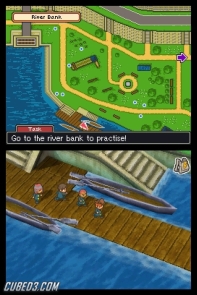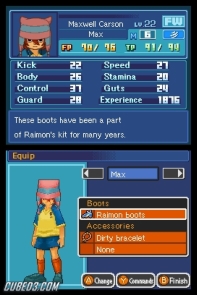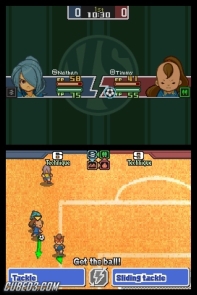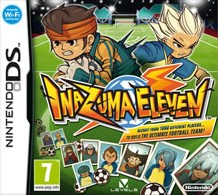Inazuma Eleven (Nintendo DS) Review
By Adam Riley  16.08.2011
16.08.2011

Back in 2008, Nintendo fans were mainly aware of Level-5 for its Nintendo DS puzzle series Professor Layton, with the first game, Professor Layton and the Curious Village, taking the world by storm. The Japanese developer was going back to its roots, though, busying itself with an RPG with a twist. Inazuma Eleven fuses a traditional role-playing adventure with touch-screen football antics, yet after a year or two with no word of an English localisation, all hope of seeing the highly anticipated title released in the West faded. However, hope was renewed after Cubed3 exclusively interviewed CEO Akihiro Hino and received confirmation that the aim was for a mid-2010 launch. That deadline might have been missed, but mainland Europe and Scandinavia eventually received Inazuma Eleven on 28th January 2011, while the UK is finally getting it on 26th August. What is the US missing out on, though?
Mark Evans is a young school boy with a strong passion for football. In fact, he has a tendency to show more enthusiasm for the popular sport than his studies, something he attributes to the fact that his grandad was a famous coach, leading the legendary Inazuma Eleven to great success, with them only losing in the National Finals due to some devious trickery on the part of the dark leader of opposing side, Royal Academy. Interestingly, the storyline twists and turns considerably, keeping the central theme of Evans and his Raimon school friends aiming to be the best team ever, yet taking significant deviations to spice matters up and keep the player guessing as to where the tale will finally end.
Back when Inazuma Eleven first launched in Japan, it certainly was quite the looker, with cute little characters running around impressive 3D locations, complete with some amazing sequences for special moves during the plentiful supply of football matches that take place throughout. Now the Secret of Mana-esque character sprites, with their tiny shadows to imitate a sense of depth, do still retain a certain amount of charm, but compared to how other DS games have progressed in the visual stakes, they do not quite muster up the same level of quality expected in today's world. In the same breath, the luscious surroundings environments and accompanying manually operated rotating camera are a pleasure to witness, whilst the 3D polygonal mid-match sequences for special manoeuvres are right up there with the best on DS, showing glimpses of how Level-5's expertise in handheld development led to securing the lucrative Dragon Quest IX: Sentinels of the Starry Skies project from Square Enix.
Equally, the music for games in general is very important, yet for an RPG it is an aspect that can help make or break the whole experience. Therefore, it is no surprise a true genius in video game composition was brought in for Inazuma Eleven. Yasunori Mitsuda and his company, Procyon Studio, were drafted in to work on the soundtrack, and Mitsuda-san's trademark rousing tunes are ever present, alongside a mass of melodic, calming music that not only matches the circumstances faced, but also soothes players during the occasionally extremely trying adventure. A first-rate musical score can make all the difference and in Inazuma Eleven it is of the highest calibre and well worth finding the official soundtrack somewhere to truly appreciate even the subtle nuances that are present.

That is not to say the gameplay of Level-5’s first football RPG hybrid product is not up to scratch. In fact that would be far from the truth, since every moment of Inazuma Eleven is a true joy to play through, betwixt the general exploration of the (admittedly limited number of) locations on offer and the expertly crafted stylus-controlled football action, this amalgamation of genres fits hand-in-glove in a way that nobody could likely have expected.
The basic idea is that in the role of Mark, a budding young goalkeeper, you must aim to recruit as many players as possible to form the best possible group, following in the footsteps of the legendary Inazuma Eleven, trying to win the prestigious Football Frontier tournament, initially with the aim of overcoming rival squad, the Royal Academy, but coming face-to-face with all manner of weird, wonderful, and sometimes ruthlessly evil teams along the way. Everything, including control of Mark in the adventuring sections, can be controlled using the touch-screen. When it comes to walking, as with Level-5’s Dragon Quest IX, dragging the stylus further along the lower screen increases the speed at which the main character moves, with his troupe trotting along in a row behind. Other people can be interacted with by simply tapping on them, and treasure chests lying around the area are similarly accessible.
The story is driven along via various triggers, such as talking to key people, finding specific items or fulfilling certain tasks. In some RPGs this can be tiresome due to the amount of random wandering around required. However, Inazuma Eleven guides players by not only talking about what to do next in conversations between players, but also flashes up the current objective on the screen briefly, and then keeps a log of it in the menu screen. In fact, there are times where the hand-holding can actually work against the game, since it becomes stifling and removes some of the fun had with a little extra exploration. For those being introduced to the RPG genre it works perfectly, but veterans may well find the constant reminders of what to do rather overbearing.

Anyone that hates random enemy encounters, though, will be over the moon about knowing the direct route required to reach the next checkpoint in the adventure. They will also be singing from the rooftops about how there is a limited world to investigate. On the other hand, those hoping for a meaty quest like Level-5’s previous Dark Cloud titles, or Square Enix’s array of Nintendo DS role-playing games, will be highly disappointed by the lack of travelling from location to location, instead traversing the land via an overview map that warps the team to one of the handful of areas that can be visited. The ten chapter structure also proves to be rather short-lived when playing directly, not diverting from the story’s path to collect as many players as possible or to level-up the team considerably. Some of the football matches played may be tough, but once used to the system and your squad selection’s strengths, the whole journey will be completed in around 15-20 hours, which is still respectable, just not quite as ‘epic’ as other DS genre stable-mates. Level-5 does a great job of making the whole game seem vast by the inclusion of stunning animated, and fully voiced, cut-scenes that pad the story out considerably, and follow the gist of the first season of the accompanying TV show.
After a certain point in the storyline, wandering around results in random battles. These occur in the form of short football matches that all take place in a 4-on-4 scenario, the purpose being to retain possession, tackle the opponents or score a goal within the allotted time in order to gain experience and boost individual players. Play takes the form of a plan view of the pitch with the small sprites stood in the positions you set for them in the formation menu screen prior to matches. These can be manually moved around before kick-off as well, meaning that you can tweak with the greatest of ease before the game even starts. To make a team member run, it is merely a case of using the stylus to literally draw a path out on the touch-screen and watching as said player attempts to follow the route laid before him/her until the ball either goes out for a throw-in, corner, goal kick or play is interrupted by being offside or committing a foul, or if someone is tackled.
When tackles come flying in, a battle of stats commences, and if your character has the edge, in terms of energy level as well, then it will be able to brush off the advances with the greatest of ease. As with the different classes of pocket monsters, the team members in Inazuma Eleven each have their own affinity to a particular power, each possessing strengths and weaknesses over one another in a rock-paper-scissors fashion. Taking this into account is imperative to claiming a quicker victory, especially in the major games that get played at turning points en-route to the final. These bigger events are full-on 11 vs. 11 games, where quick stylus drawing acuity is required to navigate team members around the pitch towards the goal, passing, lobbing, and shooting in the most skilful manner possible, whilst making use of the special abilities that have been gathered through training during the main story.

The elaborate manoeuvres - all of which use up energy meaning care must be taken not to overuse them - are weird and wonderful tricks, such as creating clones of yourself to confuse the opponent, causing the earth to shake and defenders to lose their footing, or even simple moves like flicking the ball over the head of someone charging in your direction. These features play an important role in defeating the strong teams faced along the road, with some working only when two team members work together, unleashing a mighty force that no defender can block, nor any goalkeeper able to parry. Rather than relying on mere brute force to win, though, keeping an eye on the latest equipment for your squad is useful, with stamina items, new kit and special upgrades available either in treasure chests that are randomly generated each time an area is revisited, or any stores nearby. Other important elements to factor in when building the ideal team are the usage of blue crystals and lightning bolt structures, with the former rejuvenating the team and the latter offers training sessions, at a price, in order to boost skills of individuals.
During the quest to become the best, it is possible to meet more than 1,000 different characters, many of which can be scouted and an extra 50 or so that can be obtained via the online Nintendo Wi-Fi Connection, with each having their own set of individual skills, abilities and statistics that can help with the decision as to whether or not they make the final team selection. It is this Pokémon-esque collection element that grabbed the attention of nearly 500,000 Japanese gamers when this first launched there, and the ability to trade players using the local wireless function adds to the community feel that keeps Inazuma Eleven alive for so long, along with the four-player battles to up the competitive stakes.
When Inazuma Eleven first hit the Nintendo DS back in 2008 it looked and felt like one of the best experiences on the system. Now, three years later, it is debuting in a European marketplace that has seen Chrono Trigger, Final Fantasy IV, Avalon Code, and both Kingdom Hearts: 358/2 Days and Kingdom Hearts Re:coded. Basically, the bar has been raised, and although Level-5’s first entry into this now multi-million selling series is still a thorough delight to play through, there are aspects that have aged (graphically) and others that water down the experience somewhat compared to other RPGs (too high a frequency of hand-holding hints). That is not to say fans of the genre will not have a fantastic time with Inazuma Eleven, as it is full of charm, includes a superb touch-screen football mechanic interlaced with a joyful story, complete with a simply outstanding soundtrack draped right across it.

Cubed3 Rating
Great - Silver Award

Back in 2008 Inazuma Eleven was a superb amalgamation of the football world and that of a regular RPG, with the two forces co-existing happily in the same game. Fast-forward to 2011 and the UK is finally getting what is still a brilliant experience, and a masterfully constructed product, but there have been many other examples to reach these shores that have the edge slightly. Be sure to check out Inazuma Eleven and hope that it sells well enough to get the superior sequel also localised.

![]() 8/10
8/10
![]() 8/10
(8 Votes)
8/10
(8 Votes)
 Out now
Out now  None
None  Out now
Out now  Out now
Out now Comments
Comments are currently disabled

 Sign In
Sign In Game Details
Game Details Subscribe to this topic
Subscribe to this topic Features
Features





 Top
Top

